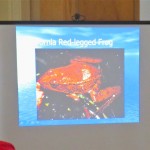During our January 17 LATO Lunch Club, Santa Margarita School nature detectives had fun learning about frog biology and ecology with professional biologist and frog lover Brooke Langle.
We [icon style=”heart” color=”ff0099″] frogs!
Brooke was assisted by Cal Poly wildlife biology senior and LATO docent Keelan Dann, as well as Cal Poly Science Senior Project student Ashley Beeman, LATO docent Mike Klatt, and Oak Ambassador Chris Lawson. Ms. Beeman prepared the questions below to help us review what we learned. Thanks to Ms. Langle and all who helped with this month’s presentation. To learn more about Ms. Langle’s work as a professional biologist and Board Trustee for The Land Conservancy, visit Terra Verde Environmental Consulting and The Land Conservancy’s Board of Trustees’ page.
[toggle title=”What does the word Amphibian mean?”]Double life. This is very appropriate for frogs and toads because their life cycles include both aquatic and terrestrial phases.[/toggle]
[toggle title=”What are some of the main differences between frogs and toads?”]Toads have drier, warty skin; stumpy bodies and heads; lay eggs in long chains; and prefer drier habitats. Frogs have smooth skin, sleek bodies, lay eggs in large clusters, and prefer wetter habitats.[/toggle]
[toggle title=”What are some distinguishing characteristics of the California Red-Legged Frog?”]Dorsolateral fold, creamy white chin strap, hind legs have reddish color underneath.[/toggle]
[toggle title=”What special adaptation does the Western Spadefoot toad have on its hind feet and what does it do?”]It has a black spade that helps it dig holes for it to burrow in.[/toggle]
[toggle title=”Which local amphibian exudes, as a defense mechanism, a goo that smells like peanut butter?”]The Western spade foot toad.[/toggle]
[toggle title=”Lunch Club vocabulary review”]Tympanum, brackish, amplexus…Which one means drum and refers to a frog’s ear?[/toggle]
[toggle title=”One more comment from Brooke and where to find more cool information about amphibians: “]I think one really amazing feature I didn’t focus on or discuss is the ability for frogs to breathe under water – they still breathe air on the surface, but can also conduct gas exchange in the water when they need to stay under for a period of time or in a hibernation mode. Here is a good link to discuss this: http://www.thefrog.org/biology/breathing/breathing.htm










